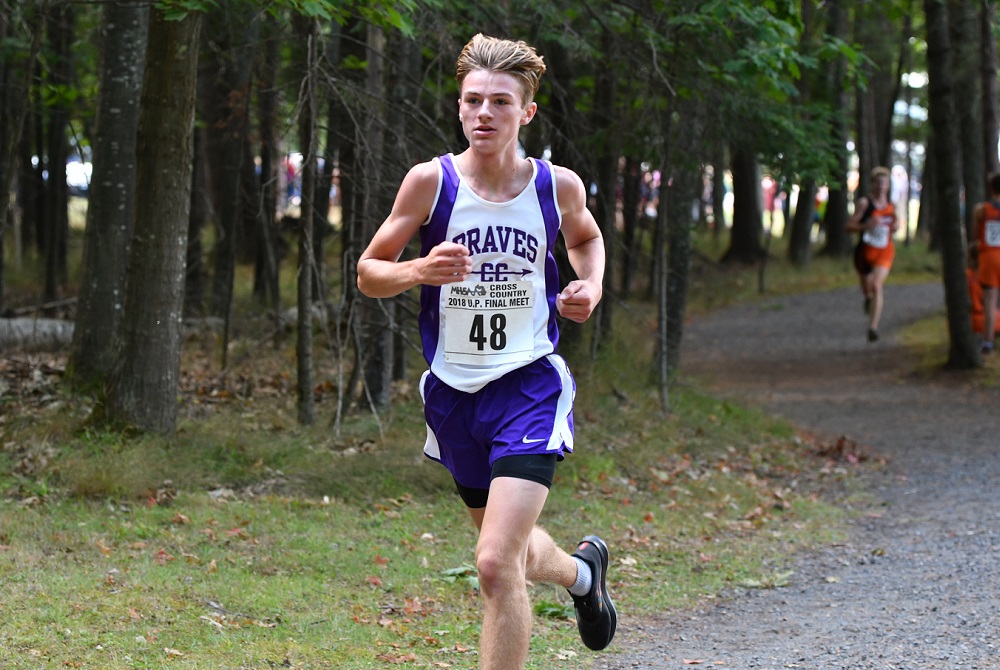
Gladstone Ace Shaving Seconds, Stacking Wins in Building Memorable Run
By
John Vrancic
Special for MHSAA.com
October 7, 2021
GLADSTONE — Drew Hughes has been piling up victories throughout this cross country season.
 The Gladstone High School junior won for the ninth time in as many races Tuesday, finishing first at the Gladstone Invitational at Richer's farmhouse.
The Gladstone High School junior won for the ninth time in as many races Tuesday, finishing first at the Gladstone Invitational at Richer's farmhouse.
That victory came three days after earning top honors at the Sault Ste. Marie Elks Invitational by covering the 3.1-mile course in 16 minutes, 35 seconds. At Munising on Sept. 28, he ran a personal-best 16:22.4 in the El Harger Memorial Invitational at Pictured Rocks Golf & Country Club, shaving seven seconds off his previous best at the Holly Invitational on Sept. 18 at Davisburg.
What has made him so successful?
“It’s probably the training I did this summer,” said Hughes, who averages 20 miles a week. “I ran with a lot of my friends, and they pushed me a lot. Although, most days I was running by myself. After a meet when I get a good time, I just want to keep getting better.”
Hughes has finished under 17 minutes in his last five races, including the John Prokos Memorial Invitational in Escanaba where he was clocked at 16:47 on Sept. 25. He also ran a 16:47 on Tuesday.
After the Holly Invite, he was selected the Athlete of the Meet for Division 3-4-5 after becoming the first male runner from the Upper Peninsula to take top individual honors in the meet’s 53-year history.
“I thought that was real cool,” said Hughes, who ran a 5:10 split in his first mile. “After the first mile, I wanted to keep that pace. I also wanted to make sure I didn’t burn out. I slowed down slightly in the second mile, but not too much. Coach (Gary Whitmer) told me my two-mile split. At that point, I wanted to go for under 17.”
Gladstone placed third at Sault Ste. Marie with 84 points. South Lyon won at 27, followed by the host Blue Devils with 51.
“My teammates and coaches have been very helpful, and they’ve been helpful and respectful to other teams,” said Hughes. “We’re a real good small team.”
On race day, he enjoys the competition and camaraderie with other runners.
“Marquette is real solid and fun to race against,” he said. “Houghton is doing well, and Sault is fun to race against. They have a nice course up there.
“My girlfriend and whole family come to the meets when they can. They’re also very supportive even when they can’t make it to the meets.”
Hughes started running in third grade under former coach Dan Paul.
“I just loved running,” he said. “My brother Luke was among the best runners in middle school, and that really motivated me. He had a lot of speed and height. In second grade, I started getting interested in running by watching him. They had a lot of people there. That was awesome.
“Our coach would treat us to ice cream after some practices. He and my grandfather came with us and rode their bikes while we were running.”
Hughes hopes to retain his Great Northern Conference title at Menominee on Oct. 14 and Mid-Peninsula Conference crown in Ishpeming on Oct. 18.
The season ends with the Upper Peninsula Finals on Oct. 23 at Gentz Golf Course in Chocolay Township (near Marquette). Hughes finished 12th in the Division 1 race in 2020.
 John Vrancic has covered high school sports in the Upper Peninsula since joining the Escanaba Daily Press staff in 1985. He is known most prominently across the peninsula for his extensive coverage of cross country and track & field that frequently appears in newspapers from the Wisconsin border to Lake Huron. He received the James Trethewey Award for Distinguished Service in 2015 from the Upper Peninsula Sportswriters and Sportscasters Association.
John Vrancic has covered high school sports in the Upper Peninsula since joining the Escanaba Daily Press staff in 1985. He is known most prominently across the peninsula for his extensive coverage of cross country and track & field that frequently appears in newspapers from the Wisconsin border to Lake Huron. He received the James Trethewey Award for Distinguished Service in 2015 from the Upper Peninsula Sportswriters and Sportscasters Association.
PHOTO Gladstone's Drew Hughes leads and wins the Dale Phillips Invitational on Sept. 3 at Presque Isle Park. (Photo by Cara Kamps.)

MHSAA Vault: MIS Rose to Challenges to Host 2020 LP Finals
By
Rob Kaminski
MHSAA benchmarks editor
November 12, 2021
The “MHSAA Vault” features stories from past publications and other documents in the MHSAA Library. This issue takes a look at the MHSAA Cross Country Finals at Michigan International Speedway, which celebrated 25 years in 2020 – although it was an event that nearly didn’t happen last fall …
In 1996, the MHSAA and Michigan International Speedway began a partnership the changed the course of the Lower Peninsula Cross Country Finals – quite literally.
The land in and around the track at Brooklyn would host the Finals for all classes of runners in one place on one day, an annual festival of nearly 2,000 runners competing for the MHSAA’s top honors.
Even skeptics – and there were several among running purists who thought the course was too flat, for example – can’t deny the results.
Finals attendance nearly doubled in that first year, and crowds in excess of 10,000 have enjoyed a day of racing several times, including a record 12,153 in 2011.
Enthusiastic crowds were the norm in recent years, with 11,232 in 2017, and nearly 11,000 in 2018 (10,989) and 2019 (10,873).
In fact, attendance failed to reach at least 8,000 only twice since the move to MIS.
Of course, last year was an exception, when attendance was limited to 1,000 spectators per session due to the COVID-19 Pandemic. Fans also were restricted to the grandstands rather than following the action throughout locations on the course.
To reduce the number of runners in each race, the event was spread over two days, with each Division being run in two separate “sections” with times then combined at the end to determine team and individual champions.
While not ideal, the end result was another year of fantastic efforts at MIS – both from student-athletes and those behind the scenes.
“Even at the last hour, less than a week ahead of the Finals, we were closer to not having the Finals than we were to having them,” said MHSAA Assistant Director Cody Inglis, who coordinates the cross country postseason. “Rumors and challenges of mandated shutdowns, testing and other requirements were being discussed and caused a lot of unknowns. Even at the Regional level, we had schools, Regional courses and hosts shutting down their facilities; we had to relocate four Regionals 48 hours prior to race times. That scenario just could not happen at the Finals level where far more runners and much more travel would be involved.”
Among the many last-minute hurdles was the edict from NASCAR – which owns MIS – that all persons on site be temperature checked upon entry. That meant securing thermometers that were easy to operate in short order, along with personnel necessary to conduct the readings.
The attendance limitations certainly helped to implement the temperature screening, but brought their own issues.
“Limiting spectators was not a popular decision, but it really was the only way to have a race,” Inglis said. “We were taking direction and working with policies and protocols from the MDHHS, the Governor’s office, Lenawee County Health Department, MIS and NASCAR.”
Part of the solution was to utilize the grandstands as a “barrier” between participants and spectators. The reduced number of fans were dispersed over thousands of seats while still allowing them the chance to watch their student-athletes compete.
“It wasn’t the same, it wasn’t easy or perfect, but it was what we had to do to have a race,” Inglis said. “Separating the Finals into two days and different sections also allowed us to spread out the event and limit the number of people on site at any one time. This was a key part of the plan and worked well even though it separated races within a Division.”
The MHSAA, MIS and the cross country community never lost focus of the main goal: a culmination of the season for the student-athletes, who deserved something last year more than ever. And, more than ever, MIS once again displayed its advantage as a venue that could adapt to the fluid nature of the times to pull off the event.
“There were some thoughts of using four different sites, but as we learned during the Regionals, the climate of things was so tenuous from one area of the state to another that we couldn’t be 100-percent certain that there wouldn’t again be last-minute cancelations,” Inglis said. “MIS was wonderful to work and collaborate with, and was the best option to get it done. It was never mentioned once publicly about the possibility of not having the Finals – only how we could best do it under uncharted conditions.”
The moving parts and ever-changing scenarios created more complexity than ever in finalizing a season, but every decision was made with the complete desire to conduct the Finals as close to normal as possible.
“I firmly believe that a finish to the season, no matter the differences in race formatting and fan experience, was something everyone would have taken when the season began in August,” Inglis said.
Indeed, the finish line in Year 25 at MIS might have been the most gratifying of them all.

